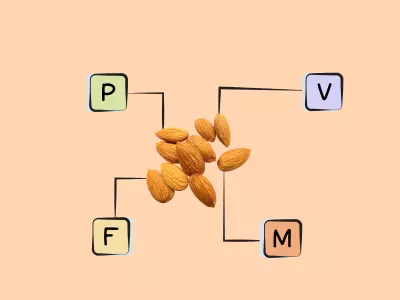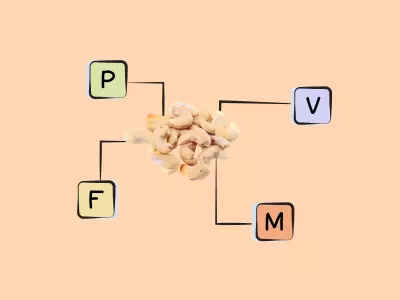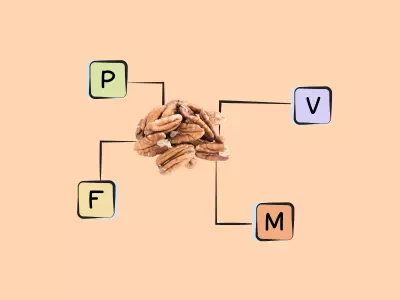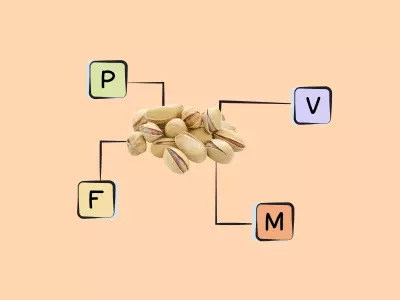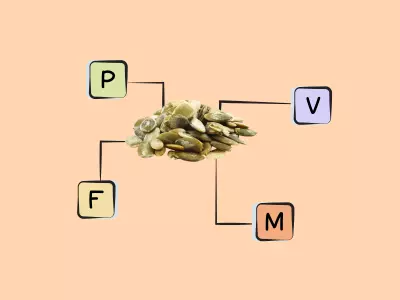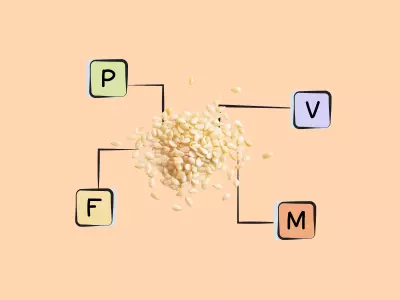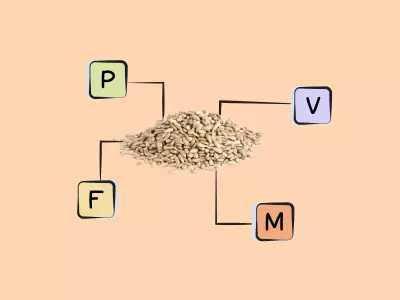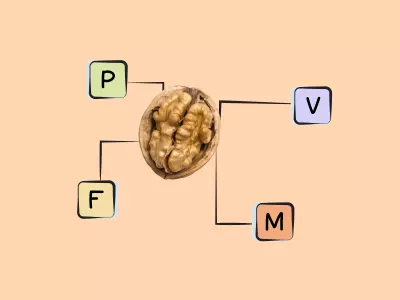Table of Contents[Hide][Show]
Health Benefits of Nuts and Seeds+−
- Nuts and Seeds Protect Against Mortality
- Nuts Protect Against Cancer
- Nuts and Seeds Protect Against Cardiovascular Disease
- Nuts and Seeds Protect Against Oxidative Stress and Inflammation
- Nuts and Seeds Contribute to Body Weight Management
- Nuts and Seeds Improve Glycemic Control
- Nuts and Seeds Improve Cognitive Performance
- Nuts Help Prevent Depression
- Nuts & Children
- Examples of Nuts and Seeds
- Nutrients in Nuts and Seeds
Health Benefits of Nuts and Seeds
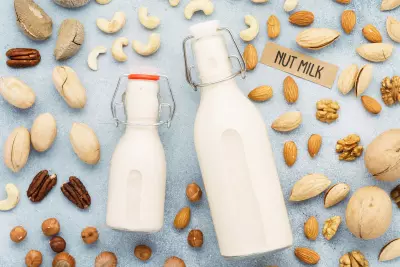
Nuts and seeds are one of the oldest-consumed foods, with archaeological excavations unearthing primitive nut-cracking tools dating back 780,000 years! Today, nuts and seeds are still popular foods. In fact, nut intake has increased considerably in the last 20 years and each year, 4.5 million metric tons of tree nuts are produced globally (that’s a lot of nuts!). Since ancient times, not only have nuts been part of the human diet, but they have been used for their medicinal properties as well. Nuts and seeds are typically regarded as nutritious, health-promoting foods and are one of the best whole-food fat sources out there. There are many different varieties of nuts including almonds, Brazil nuts, cashews, chestnuts, hazelnuts, pecans, and pine nuts just to name a few. Seeds include sunflower seeds, pumpkin seeds, poppy seeds, sesame seeds, hemp and chia. Peanuts, on the other hand, are actually a legume and don’t belong in the nut family contrary to popular belief; given the availability of nuts with far more benefits and fewer risks than peanuts, we should consider choosing other varieties to include in our diet instead.
The health benefits of nut and seed consumption can be attributed to their nutritional content, rich in antioxidant vitamins, essential minerals including being a major dietary source of magnesium, dietary fiber, and L-arginine, plus some nuts contain high levels of heart-healthy monounsaturated fats and the omega-3 fatty acid α-linolenic acid. Brazil nuts are fantastic sources of selenium (a relatively hard-to-get antioxidant mineral), pistachios are rich in prebiotic fiber, walnuts are high in anti-inflammatory omega-3 fats, sunflower seeds are extremely high in vitamin E, and nuts and seeds in general tend to be good sources of copper, manganese, vitamin B1, vitamin B9, tocopherols (vitamin E), phytosterols, and phenolic compounds. Overall, nuts and seeds are a valuable addition to the menu to help ensure nutritional adequacy!
Not surprisingly, numerous in vitro, in vivo, clinical, and epidemiologic studies have associated nut intake with a wide range of health benefits, including the modulation of glucose levels and serum lipids, positive influences on body weight, antioxidant and anti-inflammatory activities, and, consequently, protective effects against certain chronic conditions, such as cancer and cardiovascular diseases. Eating nuts and seeds on a regular basis not only improves health but can potentially extend lifespan too!
Let’s take a closer look at all of the health benefits associated with eating nuts and seeds!
Nuts and Seeds Protect Against Mortality
Several studies have shown an association between nut and seed consumption and reduced risk of all-cause mortality (a measurement of death from any cause).
The 2020 Prospective Urban Rural Epidemiology (PURE) study evaluated the association of nut intake and mortality in 16 countries from 5 continents. This prospective cohort study evaluated data from subjects aged 35 to 70, from low-, middle-, and high-income countries and included 124,329 participants, followed for a median of 9.5 years. Higher nut intake (greater than 120 grams per week) as compared with lower nut intake (less than 30 grams per month) was associated with a 12% reduced risk of mortality or major cardiovascular event. Specifically, a 23% reduced risk of total mortality, 28% reduced risk of cardiovascular mortality, and an 18% reduced risk of non-cardiovascular mortality was observed, in addition to a trend to reduced cancer mortality. Wow!
Previously, a 2016 systematic review and dose-response meta-analysis of prospective studies evaluated the impact of nut consumption on mortality from various causes. A total of 29 studies from USA, Europe, Asia and Australia were included in the meta-analysis. The dose-response analyses of nut intake included 12,331 coronary heart disease cases, 9272 stroke cases, 18,655 cardiovascular disease cases, 18,490 cancer cases, and 85,870 deaths among up to 819,448 participants (that’s a LOT of data!). A mere 10-gram serving per day increase in tree nut intake was associated with an 18% reduced risk of all-cause mortality, a 27% reduced risk of coronary heart disease, an 11% reduced risk of stroke, a 25% reduced risk of CVD, a 20% reduced risk of total cancer, a 21% reduced risk of respiratory disease mortality, a 19% reduced risk of neurodegenerative disease mortality, a 36% reduced risk of infectious disease mortality, and a 34% reduced risk of kidney disease mortality! Again, all I can say is wow – or better yet, “That’s Nuts!” (Hyuck)
More recently, due to the sheer magnitude of studies available, several systematic reviews and meta-analyses have been conducted in order to evaluate the impact of nut consumption on specific disease states in more detail. It’s important to point out that some of the studies evaluate health outcomes in relation to tree nut consumption, while others look at total nut consumption, which includes tree nuts, seeds and peanuts (even though they aren’t a nut!)
Let’s take a look at what these comprehensive studies tell us.
Nuts Protect Against Cancer
A 2021 systematic review and dose-response meta-analysis of observational studies examined the association between tree nut consumption and cancer risk. The study included 43 papers on cancer risk and 9 papers on cancer mortality. Comparing the highest versus lowest intake of tree nuts, there was a 13% reduced risk of cancer and an 18% reduced risk of cancer mortality. Based on dose-response analysis, a 5 gram per day increase in total nut intake (tree nuts and peanuts) was associated with a 3% reduced risk of overall cancer, a 6% reduced risk of pancreatic cancer plus a 25% reduced risk of colon cancer, in addition to a 4% lower risk of cancer mortality!
A separate 2020 meta-analysis evaluated the association between nut intake and the risks of cancer incidence and cancer-specific mortality. Compared with no nut intake, tree nut consumption was associated with a 12% lower cancer risk (similar to the previous study). Dose-response data suggested that protective benefits against cancer increased with increased nut intake. Nut intake was observed with lower risks of colorectal, gastric, pancreatic and lung cancer. In addition, a 10% reduced risk of cancer-specific mortality was observed.
Yet another 2020 meta-analysis of prospective studies (33 studies including more than 50,000 cancer cases) evaluated the association between nut consumption and cancer risk. When comparing the highest with the lowest category of nut intake, high consumption of nuts was associated with a 10% decreased risk of overall cancer. The protective effect of nut consumption was especially apparent against cancers from the digestive system, which had a 17% reduced risk. Among different nut classes, significant association was only obtained for intake of tree nuts. The significant protective effect of nut intake against cancer was found at a minimum consumption of 9 grams per day, and the risk of cancer decreased by 10% for every 20 gram per day increase in nut consumption.
Though all 3 of these studies had similar overall findings for cancer risk and mortality, each provided additional specifics on cancer types and intake recommendations.
In addition, a 2015 study evaluated the effect of peanut, walnut and almond consumption on the development of breast cancer. Researchers evaluated 97 patients presenting with breast cancer and 104 control subjects. They found that high consumption of peanuts, walnuts, or almonds significantly reduced the risk for breast cancer by 2 to 3 times!
Learn How All Foods Can Fit into a Healthy Diet

Improve Your Diet Without Restriction
Learn how to take a non-restrictive approach to eat nutrients, enjoy food, and live well.
In this webinar, Dr. Sarah will teach you how use Nutrivore to boost nutrient intake without drastic changes, improve your relationship with food, evaluate your diet’s quality, and adopt a balanced, moderation-focused mindset for long-term success. Say goodbye to the guilt-blame cycle and discover a nourishing approach to eating.
Buy now for instant digital access.
Nuts and Seeds Protect Against Cardiovascular Disease
Numerous epidemiological studies have consistently proven an association between nut intake and reduced risk of CVD, ischemic heart disease (IHD), and CVD incidence and mortality. The primary mechanism associated with these benefits is the improvement of lipid and apolipoprotein profile.
We’ve already covered some studies that demonstrated beneficial impacts of nuts on heart health in the mortality section, but let’s take a look at a study dedicated to cardiovascular health specifically.
A 2019 meta-analysis of prospective cohort studies, including 19 studies, evaluated the impact of nut consumption on the incidence of CVD and CVD mortality. When comparing highest versus lowest intake categories, researchers found that nut consumption was associated with lower risk of:
- atrial fibrillation (15% lower risk),
- CHD mortality (24% lower risk),
- coronary heart disease (CHD) incidence (18% lower risk),
- CVD incidence (15% lower risk),
- CVD mortality (23% lower risk), and
- stroke mortality (17% lower risk).
Wow!
Due to their dietary fiber content, magnesium, polyunsaturated fatty acids, vitamin E, folic acid, flavonoids, polyphenols, and L-arginine, nuts are thought to play an important role in reducing the cardiovascular risk through multiple mechanisms. These include having a positive influence on: glucose and/or lipid homeostasis, obesity, hypercholesterolemia, metabolic syndrome or type 2 diabetes, blood pressure, oxidation biomarkers and antioxidant defenses, flow-mediated dilatation, or DNA modification and inflammatory status. In addition, nut consumption was shown to significantly improve endothelial function, which is an important risk factor for CVD.
Let’s take a look at some of these mechanisms in detail!
Nuts Improve Lipid Profiles & Help Lower Cholesterol
Increasing nut intake has a cholesterol-lowering effect, even in the context of healthy diets! In fact, nuts are considered one of the best food groups at reducing LDL cholesterol and total cholesterol!
A 2020 systematic review evaluated the effect of tree nut consumption on serum lipid profiles in hyperlipidemic individuals. A total of 29 studies were evaluated and included participants of different ages, sex, and serum lipid profile, and varied with respect to tree nut type, study duration, dose, and nut forms. Study length ranged from 3 weeks up to 12 months and doses ranged from 15 to 126 grams. Researchers found that all studies indicated positive changes in the lipid profile after nut intervention, particularly on total cholesterol, HDL-cholesterol, LDL-cholesterol, triglycerides, and the ratio of total cholesterol to HDL-cholesterol. Bottom line, eating nuts is beneficial to serum lipid profiles!
Another 2020 meta-analyses of randomized clinical trials evaluated the comparative effects of different types of nuts on blood lipids. Researchers looked at the impact of almonds, cashews, hazelnuts, pistachios, and walnuts on typical lipid profiles. In total, 34 trials (1677 participants), were included. The pistachio-enriched diet was ranked best for triglycerides, LDL-cholesterol and total cholesterol reductions. For triglycerides and total cholesterol reductions, the walnut-enriched diet was ranked as the second-best diet. Regarding LDL-cholesterol reduction, the almond-enriched diet was ranked second best. The pistachio-enriched and walnut-enriched diets were more effective at lowering triglycerides, LDL-cholesterol, and total cholesterol compared with the control diet. What this tells me is that variety is key in maximizing benefits associated with consuming nuts. I know I sound like a broken record, but variety is important when making all our food choices!
Nuts Improve Blood Pressure
A 2015 systematic review and meta-analysis of 21 randomized controlled clinical trials evaluated the impact of tree nuts on blood pressure. Researchers determined that total nut consumption resulted in a significant reduction in systolic blood pressure (SBP) in participants without type 2 diabetes, but not in the total population. In sub-group analysis, only pistachios significantly reduced SBP. In addition, mixed nut (including walnuts, almonds, pistachios, cashews, hazelnuts, macadamia nuts, pecans, peanuts, and soy nuts) intake significantly reduced diastolic blood pressure.
Nuts and Seeds Protect Against Oxidative Stress and Inflammation
Nuts and seeds are sources of tocopherols and phenolic compounds with potent antioxidant and anti-inflammatory properties. As such, it’s no surprise that a large number of in vitro, in vivo, and epidemiological studies have highlighted the beneficial effects of nut intake on inflammatory and oxidative processes.
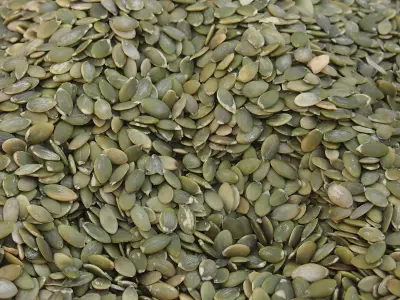
For example, a 2020 systematic review of clinical trials evaluated the effect of chronic nut consumption on oxidative stress. A total of 16 studies were included, with follow-up times ranging between 4 weeks and 6 months. Overall, eight studies reported improvements in oxidative stress biomarkers after nut supplementation and no studies reported harmful effects of nut consumption, even at high doses. Researchers concluded that chronic consumption of nuts seemed to be effective in changing some oxidative stress biomarkers, however the benefit depended on nut type, dose, and population characteristics. The mechanisms involved in these beneficial effects included pathways regulated by selenium (glutathione peroxidase activity and Nrf2 regulation), monounsaturated fatty acids (reductio of LDL oxidation), and bioactive compounds (antioxidant activity).
Nut consumption is also known to decrease markers of inflammation, including CRP, IL-6, TNF-α, IL-18 and some endothelial markers (called adhesion molecules).
Overall, studies suggest that nut intake may contribute to protection against oxidative stress and the related consequences of inflammatory processes, mostly due to the abundance of secondary metabolites such as phenol compounds, flavonoids, and carotenoids, which are present in the skin and in the kernel of nuts. Other factors, including polyunsaturated fatty acids, antioxidant vitamins, dietary fiber, L-arginine, and magnesium may play an important role in modulating inflammation as well.
Nuts and Seeds Contribute to Body Weight Management
Despite their energy density, nuts and seeds don’t contribute to weight gain in the general population and may even protect against obesity! This is probably because of their gut microbiome effects.
A 2021 systematic review and meta-analysis evaluated the relationship of tree nuts and peanuts with adiposity parameters including body weight (BW), body mass index (BMI), waist circumference (WC), and body fat percentage (BF%). A whopping 105 randomized controlled trials were included! With the exception of a hazelnut-enriched diet raising WC, there was no significant increase observed in any of the adiposity-related measures when comparing nut consumption versus a control diet. Despite negative connotations associated with the high fat-content of nuts, researchers concluded tree nut and peanut consumption do not influence adiposity. Almond-enriched diets significantly reduced WC compared to the control diet and the pistachio-, mixed nuts-, and hazelnut-enriched diets. Sub-group analyses also showed that almonds were associated with reduced BMI.
Another 2021 systematic review and meta-analysis further evaluated studies that concluded nut consumption did not cause weight gain and determined that nut-enriched diet interventions did not result in changes in body weight, BMI, or waist circumference whether or not dietary substitution instructions were given to study participants.
A separate 2021 systematic review and meta-analysis of randomized controlled trials evaluated the impact of nut consumption and weight gain in individuals with type 2 diabetes. A total of 15 studies (899 individuals) were included. Researchers concluded nut consumption had no effect, positive or negative, on weight or adiposity parameters (including BMI, waist circumference, or percent body fat) in people with type 2 diabetes.
Overall, the large number of studies conducted have shown no adverse effects of nut consumption on energy balance or body weight. In addition, nut consumption, (thanks to their combination of unsaturated fatty acids, dietary fiber, plant protein, antioxidants, vitamin E, arginine, phytosterols, and minerals such as potassium, calcium, and magnesium, plus non-bioaccessible nutrients, with prebiotic properties), has been shown to be inversely associated to metabolic syndrome and excess weight.
Bottom line, all these studies are showing that we don’t need to shy away from nuts and seedsout of fears that they contribute to weight gain.
Easily track your servings of Nutrivore Foundational Foods!

The Nutrivore Weekly Serving Matrix
The Nutrivore Weekly Serving Matrix digital resource is an easy-to-use and flexible weekly checklist designed to help you maximize nutrient-density and meet serving suggestions of Nutrivore foundational foods, all without having to weigh or measure your foods!
Includes a 22-page instructional guide and downloadable interactive guides.
Buy now for instant digital access.
Nuts and Seeds Improve Glycemic Control
It’s unclear whether nut and seed consumption impacts incidence of type 2 diabetes. For instance, a 2021 systematic review and meta-analysis of observational studies evaluated the effect of nut consumption on the prevalence and incidence of type 2 diabetes, across eight studies. Researchers found a non-significant association between total nut consumption or tree nut consumption and type 2 diabetes.
However, several studies have highlighted the role of nut and seed consumption in modulating glucose homeostasis in healthy, pre-diabetic, diabetic, and obese subjects. For instance, a 2021 systematic review evaluated the effect of tree nuts on glycemic outcomes in adults with type 2 diabetes. The study included fifteen trials with a total sample size of 667. Researchers found consumption of tree nuts resulted in a reduction in both fasting blood glucose and glycated hemoglobin in under three months. Subgroup analyses showed the magnitude of effect varied based on nut type.
The beneficial role of nuts in glucose and insulin metabolism has been associated with their content of fiber, fat, minerals, and other bioactive molecules. Specifically, the fiber and fat content of almonds, the PUFA content of walnuts, and the PUFA content and the procyanidins, γ-tocopherol, and carotenoids such as lutein and β-carotene of pistachio are responsible for these positive outcomes.
Nuts and Seeds Improve Cognitive Performance
Neurons are particularly susceptible to oxidative stress. Given the high amount of omega-3 fatty acids, vitamin E, and antioxidants found in nuts, they can protect neurons from free radicals and other reactive oxygen and nitrogen species and slow down cognitive decline. Furthermore, foods rich in omega-3 fatty acids, such as nuts, may help build and repair the brain damaged cells. Phenols, polyphenols, and vitamins also reduce cellular oxidative stress onset, inflammation, and activation of the apoptotic pathway, which could be directly linked to brain aging and neurodegeneration. Despite this, studies looking at the effect of nut consumption on cognitive health have had varying results.
For instance, a 2021 systematic review, including 22 articles and 43, 793 participants, evaluated the impact of nut consumption on cognitive performance. Lack of consistency across the studies regarding study design, nut type, and cognitive outcomes measured resulted in inconsistent evidence that the regular consumption of mixed nuts has a protective effect on cognition in adults of different ages. However, researchers observed that studies targeting populations with a higher risk of cognitive decline tended to find a more favorable outcome. Furthermore, more consistent findings were observed in the studies that specifically addressed the association between walnut consumption and cognitive performance.
Previously, a 2019 systematic review, including 19 articles, had evaluated the relationship between nut consumption and cognitive function and concluded that in most studies a protective effect of nut consumption on some dimension of cognitive function was observed. The effects appeared to be independent of nut type, dose, age and baseline status of subjects. However, results were difficult to interpret and authors indicated better designed longitudinal studies were needed for confirmation.
A 2021 study looked at the associations between nut intake, cognitive function and non-alcoholic fatty liver disease (NAFLD) in older adults in the US. Older adults from the NHANES study (National Health and Nutritional Examination Surveys Study) were categorized into one of four groups based on their habitual nut intake including non-consumer, low intake (0.1 to 15.0 grams per day), moderate intake (15.1 to 30 grams per day) or high intake (greater than 30 grams per day). Researchers found cognitive scores were lowest in non-consumers and significantly highest in the moderate intake group, with no further increase in cognitive scores in those consuming more than 30 grams per day. Moderate nut intake was also associated with better immediate and delayed memory in those with high risk of non-alcoholic fatty liver disease (NAFLD). Overall, nuts and oils were found to be one of the four major dietary patterns associated with better cognition and lower fatty liver index (FLI) scores!
Nuts Help Prevent Depression
For example, a 2016 cohort study, looking at 13,626 inhabitants in Tianjin, China evaluated the relationship between nut consumption and depressive symptoms. Researchers found a reduced risk of elevated depressive symptoms by increasing the frequency of nut consumption and concluded that nut consumption may be beneficial to the prevention of depressive symptoms. Relative to nut consumption less than once a week, there was an 18% reduced risk of depressive symptoms with nut consumption one to three times per week or four or more times per week.
Nutrivore Is a Game-Changer—This FREE Guide Shows You Why
Sign up for the free Nutrivore Newsletter, your weekly, science-backed guide to improving health through nutrient-rich foods — without dieting harder —and get the Beginner’s Guide to Nutrivore delivered straight to your inbox!
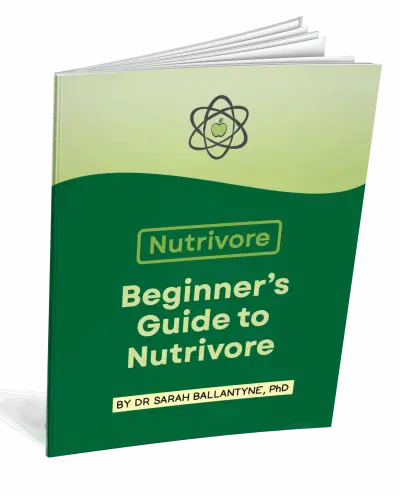
Nuts & Children
While most of the studies discussed looked at the impact of nut consumption in adults, a 2021 systematic review of randomized controlled trials evaluated the effect of nut consumption on health outcomes in children, aged 8 to 18 years old. A total of four studies were included, with nut consumption ranging between 15 and 30 grams and study durations between 3 and 16 weeks. Researchers found that nut consumption improved children’s diet quality (increasing the children’s intake of essential nutrients including monounsaturated and polyunsaturated fats, protein and fiber). However, there were inconsistent effects on biomarkers of cardiometabolic health (such as lipid profiles, microvascular reactivity and inflammation) and gastrointestinal health (increase in the proportion of beneficial fecal bacteria). They found modest improvements in gut health with some changes in the prevalence of bacterial species at the species and genus levels and a reduction in constipation with almonds, but no improvement in microbial diversity. Overall, as a result of the low number of studies it may be difficult to draw firm conclusions but it appears that nuts are healthy for children. We just need more data to figure out the magnitude of the effect.
Overall, nuts are absolute rock stars when it comes to our health, provided they are consumed in moderation, of course!
Examples of Nuts and Seeds
- almonds
- Brazil nut
- cashew
- chia
- coconut
- flax
- hazelnut
- hemp
- macadamia nut
- pecan
- pine nut
- pistachio
- poppy
- pumpkin
- sesame
- sunflower seed
- walnut
Nutrients in Nuts and Seeds
Learn What Foods Are the Best Sources of Every Nutrient

The Top 25 Foods for Every Nutrient
The Top 25 Foods for Every Nutrient e-book is a well-organized, easy-to-use, grocery store-friendly guide to help you choose foods that fit your needs of 43 important nutrients while creating a balanced nutrient-dense diet.
Get two “Top 25” food lists for each nutrient, plus you’ll find RDA charts for everyone, informative visuals, fun facts, serving sizes and the 58 foods that are Nutrient Super Stars!
Buy now for instant digital access.
Help me to keep building Nutrivore.com

I’m working on writing more awesome articles on this topic to be featured right here on this webpage. If you’re enjoying the content my team and I have created thus far and would like to see more, you can support our efforts to keep building out this site by joining the Nutrivore community on Patreon!
Plus every month, you’ll gain exclusive and early access to a variety of resources, including a weekly video podcast, a new e-book in a series, nutrient fun factsheet, and more! Sign up now and also get 5 free Nutrivore guides as a welcome gift! Win-win-win!
Citations
Expand to see all scientific references for this article.
Bennink, M.R. 2002. “Consumption of Black Beans and Navy Beans (Phaseolus vulgaris) Reduced Azoxymethane-Induced Colon Cancer in Rats.” Nutrition and Cancer. 44(1):60-65. doi:10.1207/S15327914NC441_8.
Darmadi-Blackberry, I., M.L. Wahlqvist, A. Kouris-Blazos, et al. 2004. “Legumes: the most important dietary predictor of survival in older people of different ethnicities.” Asia Pacific Journal Clinic of Nutrition. 13(2):217-220.
Li, H., J. Li, Y. Shen, J. Wang, and D. Zhou. 2017. “Legume Consumption and All-Cause and Cardiovascular Disease Mortality.” BioMed Research International. 2017:8450618. doi:10.1155/2017/8450618.
Liu W, Hu B, Dehghan M, Mente A, Wang C, Yan R, Rangarajan S, Tse LA, Yusuf S, Liu X, Wang Y, Qiang D, Hu L, Han A, Tang X, Liu L, Li W; PURE-China Investigators. Fruit, vegetable, and legume intake and the risk of all-cause, cardiovascular, and cancer mortality: A prospective study. Clin Nutr. 2021 Jun;40(6):4316-4323. doi: 10.1016/j.clnu.2021.01.016.
Monk, J.M., D. Lepp, W. Wu, K.P. Pauls, L.E. Robinson, and K.A. Power. 2017. “Navy and black bean supplementation primes the colonic mucosal microenvironment to improve gut health.” Journal of Nutritional Biochemistry. 49:89-100. doi:10.1016/j.jnutbio.2017.08.002.
Monk, J.M., D. Lepp, W. Wu; et al. 2017. “Chickpea-supplemented diet alters the gut microbiome and enhances gut barrier integrity in C57Bl/6 male mice.” Journal of Functional Foods. 38:663-674. doi:10.1016/j.jff.2017.02.002.
Papanikolaou, Y., and V.L. Fulgoni III. 2008. “Bean Consumption Is Associated with Greater Nutrient Intake, Reduced Systolic Blood Pressure, Lower Body Weight, and a Smaller Waist Circumference in Adults: Results from the National Health and Nutrition Examination Survey 1999-2002.” Journal of the American College of Nutrition. 27(5):569-576. doi:10.1080/07315724.2008.10719740.
Schwingshackl L, Schwedhelm C, Hoffmann G, Lampousi AM, Knüppel S, Iqbal K, Bechthold A, Schlesinger S, Boeing H. Food groups and risk of all-cause mortality: a systematic review and meta-analysis of prospective studies. Am J Clin Nutr. 2017 Jun;105(6):1462-1473. doi: 10.3945/ajcn.117.153148.



